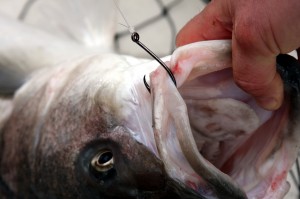 UPDATE: This post appeared earlier on ChesapeakeLightTackle.com. It has been reprinted due to recent proposals to require circle hooks year-round for bait fishing in Maryland.
UPDATE: This post appeared earlier on ChesapeakeLightTackle.com. It has been reprinted due to recent proposals to require circle hooks year-round for bait fishing in Maryland.
It’s spring in the Chesapeake Bay and time for big migratory stripers. Some of the biggest striped bass in the world are caught in Maryland in the early spring. A few fishermen are already using circle hooks to catch & release big fish on the points near the rivers using bait such as bloodworms and cut menhaden. Circle hooks aren’t just a good idea for bait fishing in the Chesapeake Bay, they’re required by law. Maryland fishermen have been slow to see the advantages of circle hooks. I think that’s because most of us haven’t used them enough, but there’s also confusion about what circle hooks are and how they work. I recently had an opportunity to travel to Providence, Rhode Island to attend a FishSmart conference sponsored by NOAA about catch & release techniques. I came away with some interesting information.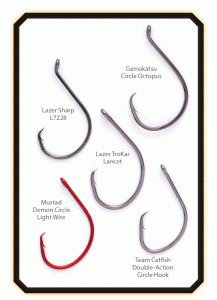
According to extension agents working with Florida Sea Grant, circle hooks have been used for decades in their state by both recreational and commercial fishermen who appreciate their ability to efficiently catch fish. The principle behind the hook is simple. After the hook has been swallowed, the fisherman applies pressure to the line, pulling the hook out of the stomach. The unique hook shape causes the hook to slide towards the point of resistance and embed itself in the jaw or in the corner of the fish’s mouth. The actual curved shape of the hook is intended to keep the hook from catching in the gut cavity or throat.
The advantage to the fisherman is that hooking is automatic. No hook set required. All we have to do is let the fish swim off with the bait then pick up the rod and start reeling. Circle hooks are a fool-proof way to catch stripers when fishing with bait, but do they work to protect the fish?
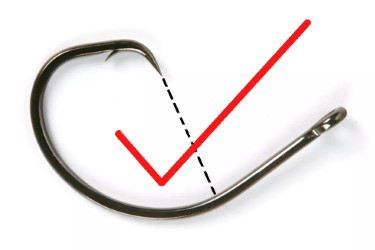 According to Maryland rockfish scientist Rudy Lukacovic, most of the time they do. Most fishermen will tell you that they still see gut-hooked fish occasionally. That’s one of the drawbacks to bait fishing, but there’s also another problem. There is unfortunately no industry standard as to what makes a circle hook. In fact, some of the hooks you buy off the bait shop shelf may not be circle hooks at all. Just because it says circle hook on the package doesn’t mean it is. There are impostors.
According to Maryland rockfish scientist Rudy Lukacovic, most of the time they do. Most fishermen will tell you that they still see gut-hooked fish occasionally. That’s one of the drawbacks to bait fishing, but there’s also another problem. There is unfortunately no industry standard as to what makes a circle hook. In fact, some of the hooks you buy off the bait shop shelf may not be circle hooks at all. Just because it says circle hook on the package doesn’t mean it is. There are impostors.
On a true circle hook, the tip of the hook points back toward the shank of the hook. If it points toward the eye, it’s not a circle hook no matter what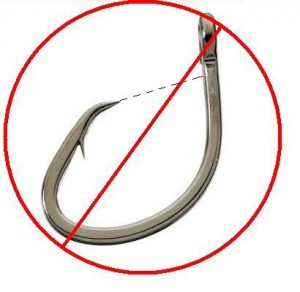 it says on the package. Confused? Then try this: Curve your index finger around the contour of the hook shank and press down a little. If you feel the tip of the hook pricking your finger, it’s not a true circle and won’t work right. The tip of the hook should curve away from your finger.
it says on the package. Confused? Then try this: Curve your index finger around the contour of the hook shank and press down a little. If you feel the tip of the hook pricking your finger, it’s not a true circle and won’t work right. The tip of the hook should curve away from your finger.
Circle hooks can be roughly divided into two types, offset and non-offset. The offset refers to the amount of deviation in the plane of the hook point relative to that of the shank. Most of the hooks you see on the store shelves are offset. That means when you lay them down on a table, they won’t lay completely flat. A true non-offset hook will lay perfectly flat on the table. Offset circle hooks are more likely to gut-hook your fish.
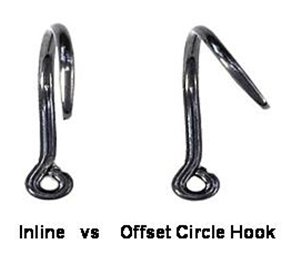 Since there can be confusion about what constitutes a true circle hook, some tournaments are specifying certain brands and types as tournament legal. Unless the industry responds by standardizing descriptions, state resource departments and lawmakers may also have to be more specific. Maryland defines a circle hook as: A non-offset hook with the point turned perpendicularly back to the shank. Circle hooks used in bait fisheries should be “non offset”. That is, if the hook is laid on a flat surface, all parts of the hook lie flat on the surface.
Since there can be confusion about what constitutes a true circle hook, some tournaments are specifying certain brands and types as tournament legal. Unless the industry responds by standardizing descriptions, state resource departments and lawmakers may also have to be more specific. Maryland defines a circle hook as: A non-offset hook with the point turned perpendicularly back to the shank. Circle hooks used in bait fisheries should be “non offset”. That is, if the hook is laid on a flat surface, all parts of the hook lie flat on the surface.
Here are some tips for using circle hooks to catch striped bass:
Keep it limber – Use a slow, limber fishing rod with a lot of bend in the tip. A stiff, fast-tipped rod is more likely to pull the hook out of the striper’s mouth when you pick it up. Ugly Stix fans, this is your cue!
Don’t bury the hook in the bait – If you hide the hook, it is less likely to catch the corner of the fish’s mouth when you start reeling. If you use live bait, hook the bait through the nose or lips so the hook is completely exposed and the gap isn’t blocked. Stripers won’t see the hook and your bait will look more natural.
Crank, don’t yank – Just set your reel to free spool, wait for the fish to take off and start reeling. If you’re live-lining, count to ten before you start. Don’t set the hook.
No need to sharpen – Sharpening a circle hook will damage the tip and make less likely to hook the mouth but more likely to hook the fish’s stomach.
Stay away from stainless – If a fish breaks off, the stainless hooks don’t rust. That means it will stay in the fish’s mouth longer. If a fish swallows a stainless hook, it will probably die.
Go big or go home – Don’t be afraid to use a big hook. A 8/0 or 9/0 hook is great for stripers. Take a look at the big rockfish in the picture below. It takes a wide-gap hook to get over those thick lips! Hooks with a gap that are too small are more likely to gut-hook the fish. For big fish in the 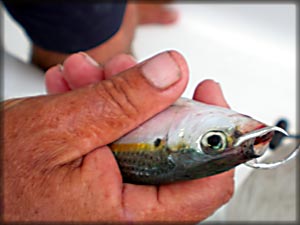 spring, use 10/0 or even bigger. Also, pay attention to the quality of the hook because you don’t want a hook that will bend or straighten.
spring, use 10/0 or even bigger. Also, pay attention to the quality of the hook because you don’t want a hook that will bend or straighten.
Catch & Release Tips
Be Prepared – If you aren’t used to using circle hooks, it might take a little longer to remove the hook from your fish. Keep your pliers, de-hooker, measuring device, and camera beside you and ready to use. If the fish swallows the hook, just cut the line as close as you can to the hook. Don’t try to pull the hook out if it’s embedded in the fish’s stomach.
Do you really need a net? – It’s a lot easier just to reach down and lip the fish with wet hands or wet rubber coated gloves. Nets cause you to lose fish and they injure them by removing slime. If you must use one, find one that has a fine, rubber coated mesh. You might even consider a a cradle net since that will let you measure your fish in the water.
Handle With Care – If you plan to release a big fish, be sure to support the body weight with both hands. If you have to lay it down to remove the hook, do it gently. Try not to drag the fish through the mud or sand because this can injure it and remove slime. Get the fish back in the water as fast as you can.
In a nutshell, circle hooks are good for the fish because fewer stripers are hooked in the stomach or in other vital organs, and they’re good for the fisherman because they increase hook-ups and reduce missed strikes. Good for the fish, good for the fisherman – that’s a winning combination.
Did you know? Circle hooks have been around for centuries. Archaeologists have recovered stone circle hooks that are tens of thousands of years old from the grave sites of indigenous cultures. J hooks came about relatively recently because they are easier to make. Once again, modern-day anglers are recognizing the benefits of circle hooks for both efficiency and conservation. This fishing technique, like the hooks themselves, has come full circle.





Shawn, I have been watching your videos. Fantastic. I want to try the snap fishing. I read your information for choosing a rod. Any brand you prefer? Did the St Croix rods work for you? What speed bait caster? I will be fishing around the mouth of the Rappahanock. Any Suggestion?